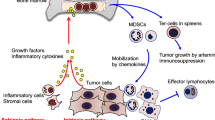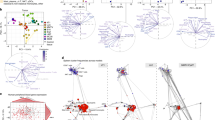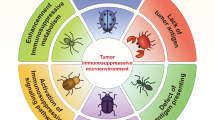Abstract
The tumor microenvironment is created by the tumor and dominated by tumor-induced interactions. Although various immune effector cells are recruited to the tumor site, their anti-tumor functions are downregulated, largely in response to tumor-derived signals. Infiltrates of inflammatory cells present in human tumors are chronic in nature and are enriched in regulatory T cells (Treg) as well as myeloid suppressor cells (MSC). Immune cells in the tumor microenvironment not only fail to exercise antitumor effector functions, but they are co-opted to promote tumor growth. Sustained activation of the NF-κB pathway in the tumor milieu represents one mechanism that appears to favor tumor survival and drive abortive activation of immune cells. The result is tumor escape from the host immune system. Tumor escape is accomplished through the activation of one or several molecular mechanisms that lead to inhibition of immune cell functions or to apoptosis of anti-tumor effector cells. The ability to block tumor escape depends on a better understanding of cellular and molecular pathways operating in the tumor microenvironment. Novel therapeutic strategies that emerge are designed to change the pro-tumor microenvironment to one favoring acute responses and potent anti-tumor activity.
This is a preview of subscription content, access via your institution
Access options
Subscribe to this journal
Receive 50 print issues and online access
$259.00 per year
only $5.18 per issue
Buy this article
- Purchase on Springer Link
- Instant access to full article PDF
Prices may be subject to local taxes which are calculated during checkout




Similar content being viewed by others
References
Albers AE, Kim G, Ferris RL, Chikamatsu K, DeLeo AB, Whiteside TL et al. (2002). Immune responses to p53 in patients with cancer: enrichment in tetramer+p53 peptide-specific T cells and regulatory CD4+CD25+ cells at tumor sites. Cancer Immunol Immunother 62: 670–679.
Aller MA, Arias JL, Nava MP, Arias J . (2004). Posttraumatic inflammation is a complex response based on the pathological expression of the nervous, immune and endocrine function systems. Exp Biol Med 229: 170–181.
Almand B, Clark JI, Nikitina E, van Beynen J, English NR, Knight SC et al. (2001). Increased production of immature myeloid cells in cancer patients: a mechanism of immunosuppression in cancer. J Immunol 166: 678–689.
Almand B, Resser JR, Lindman B, Nadaf S, Clark JI, Kwon ED et al. (2000). Clinical significance of defective dendritic cell differentiation in cancer. Clin Cancer Res 6: 1755–1766.
Bacchetta R, Gambineri E, Roncarolo MG . (2007). Role of regulatory T cells and FOXP3 in human diseases. J Allergy Clin Immunol 120: 227–235.
Balkwill F, Coussens LM . (2004). Cancer: an inflammatory link. Nature 431: 405–406.
Balkwill F, Mantovani A . (2001). Inflammation and cancer: back to Virchow? Lancet 357: 539–545.
Banerjee DK, Dhodapkar MV, Matayeva E, Steinman RM, Dhodapkar KM . (2006). Expansion of FOXP3 high regulatory T cells by human dendritic cells (DCs) in vitro and after injection of cytokine-matured DCs in myeloma patients. Blood 108: 2655–2661.
Baxevanis CN, Dedoussis GV, Papadopoulos NG, Missitzis I, Stathopoulos GP, Papamichail M . (1994). Tumor specific cytolysis by tumor infiltrating lymphocytes in breast cancer. Cancer 74: 1275–1282.
Bergmann C, Strauss L, Zeidler R, Lang S, Whiteside TL . (2007). Expansion of human T regulatory type 1 cells in the microenvironment of COX-2-overexpressing head and neck squamous cell carcinoma. Cancer Res 67: 8865–8873.
Bronte V, Serafini P, Mazzoni A, Segal DM, Zanovello P . (2003). L-arginine metabolism in myeloid cells controls T-lymphocyte functions. Trends Immunol 24: 302–306.
Chang CC, Campoli M, Ferrone S . (2005). Classical and nonclassical HLA class I antigen and NK cell-activating ligand changes in malignant cells: current challenges and future direction. Adv Cancer Res 93: 189–234.
Chen A, Liu S, Park D, Kang Y, Zheng G . (2007). Depleting intratumoral CD4+CD45+ regulatory T cells via Fasl protein transfer enhances the therapeutic efficacy of adoptive T cell transfer. Cancer Res 67: 1291–1298.
Coronella JA, Spier C, Welch M, Trevor KT, Stopeck AT, Villar H et al. (2002). Antigen-driven oligoclonal expansion of tumor-infiltrating B cells in infiltrating ductal carcinoma of the breast. J Immunol 169: 1829–1836.
Curiel TJ, Coukos G, Zou L, Alvarez X, Cheng P, Mottram P et al. (2004). Specific recruitment of regulatory T cells in ovarian carcinoma fosters immune privilege and predicts reduced survival. Nature Med 10: 942–949.
Denko NC, Fontana LA, Hudson KM, Sutphin PD, Raychaudhuri S, Altman R et al. (2003). Investigating hypoxic tumor physiology through gene expression patterns. Oncogene 22: 5907–5914.
Dranoff G, Jaffee E, Lazenby A, Golumbek P, Levitsky H, Brose K et al. (1993). Vaccination with irradiated tumor cells engineered to secrete murine granulocyte-macrophage colony-stimulating factor stimulates potent, specific, and long-lasting anti-tumor immunity. Proc Natl Acad Sci USA 90: 3539–3543.
Dworak HF . (1986). Tumors: wounds that do not heal. Similarities between tumor stroma generation and wound healing. N Engl J Med 315: 1650–1659.
Ferrone S, Whiteside TL . (2007). Tumor microenvironment and immune escape. Surg Oncol Clinics N Amer 16: 755–774.
Filipazzi P, Valenti R, Huber V, Pilla L, Canese P, Iero M et al. (2007). Identification of a new subset of myeloid suppressor cells in peripheral blood of melanoma patients with modulation by a ganulocyte-macrophage colony-stimulation factor-based antitumor vaccine. J Clin Oncol 25: 2546–2553.
Fricke I, Gabrilovich DI . (2006). Dendritic cells and tumor microenvironnment: a dangerous liaison. Immunol Invest 35: 459–483.
Gabrilovich DI, Ishida T, Nadaf S, Ohm JE, Carbone DP . (1999). Antibodies to vascular endothelial growth factor enhance the efficacy of cancer immunotherapy by improving endogenous dendritic cell function. Clin Cancer Res 5: 2963–2970.
Gallina G, Dolcetti L, Serafini P, DeSanto C, Marigo I, Colombo MP et al. (2006). Tumors induce a subset of inflammatory monocytes with immunosuppressive activity on CD8+ T cells. J Clin Invest 116: 2777–2790.
Gallucci S, Matzinger P . (2001). Danger signals: SOS to the immune system. Curr Opin Immunol 13: 114–119.
Galon J, Costes A, Sanchez-Cabo F, Kirilovsky A, Mlecnik B, Lagorce-Pagès C et al. (2006). Type, density, and location of immune cells within human colorectal tumors predict clinical outcome. Science 313: 1960–1964.
Galon J, Fridman W-H, Pages F . (2007). The adaptive immunologic microenvironment in colorectal cancer: A novel perspective. Cancer Res 67: 1883–1886.
Gondek DC, Lu LF, Quezada SA, Sakaguchi S, Noelle RJ . (2005). Cutting edge: contact-mediated suppression by CD4+cd25+ regulatory cells involves a granzyme B-dependent, perforin-independent mechanism. J Immunol 174: 1783–1786.
Greten FR, Eckmann L, Greten TF, Park JM, Li ZW, Egan LJ et al. (2004). IKKbeta links inflammation and tumorigenesis in a mouse model of colitis-associated cancer. Cell 118: 285–296.
Harrison ML, Obermuller E, Maisey NR, Hoare S, Edmonds K, Li NF et al. (2007). Tumor necrosis factor alpha as a new target for renal cell carcinoma: two sequential phase II trials of infliximab at standard and high dose. J Clin Oncol 25: 4542–4549.
Janssens W, Carlier V, Wu B, VanderElst L, Jacquemin MG, Saint-Remy JM . (2003). CD4+CD25+ T cells lyse antigen-presenting B cells by Fas-Fas ligand interaction in an epitope-specific manner. J Immunol 171: 4604–4612.
Johnson BD, Jing W, Orentas RJ . (1997). CD25+ regulatory T cell inhibition enhances vaccine-induced immunity to neuroblastoma. J Immunother 30: 203–214.
Karin M, Greten FR . (2004). NF-κB: linking inflammation and immunity to cancer development and progression. Nature 431: 461–466.
Kiessling R, Kono K, Petersson M, Wasserman K . (1996). Immunosuppression in human tumor-host interaction: role of cytokines and alterations in signal-transducing molecules. Springer Sem Immunopathol 18: 227–242.
Kornstein MJ, Brooks JS, Elder DE . (1983). Immunoperoxidase localization of lymphocyte subsets in the host response to melanoma and nevi. Cancer Res 43: 2749–2753.
Kuss I, Saito T, Johnson JT, Whiteside TL . (1999). Clinical significance of decreased ζ chain expression in peripheral blood lymphocytes of patients with head and neck cancer. Clin Cancer Res 5: 329–334.
Lanier LL . (2003). Natural killer cell receptor signaling. Curr Opin Immunol 15: 308–314.
Lee J-C, Lee K-M, Kim D-W, Heo DS . (2004). Elevated TGF-β1 secretion and down-modulation of NKG2D underlies impaired NK cytotoxicity in cancer patients. J Immunol 172: 7335–7340.
Liyanage UK, Moore TT, Joo HG, Tanaka Y, Herrmann V, Doherty G et al. (2002). Prevalence of regulatory T cells is increased in peripheral blood and tumor microenvironment of patients with pancreas or breast adenocarcinoma. J Immunol 169: 2756–2761.
Lluis JM, Buricchi F, Chiarugi P, Morales A, Fernandez-Checa JC . (2007). Dual role of mitochondrial reactive oxygen species in hypoxia signaling: activation of nuclear factor-kappa B via cSRC and oxidant dependent cell death. Cancer Res 67: 7368–7377.
Loukinova E, Dong G, Enamorado-Ayalya I, Thomas GR, Chen Z, Schreiber H et al. (2000). Growth regulated oncogene-alpha expression by murine aquamous cell carcinoma promotes tumor growth, metastasis, leukocyte infiltration and angiogenesis by a host CXC receptor-2 dependent mechanism. Oncogene 19: 3477–3486.
Mahnke K, Schonfeld K, Fondel S, Ring S, Karakhanova S, Wiedemeyer K et al. (2007). Depletion of CD4+CD25+ human regulatory T cells in vivo: kinetics of Treg depletion and alterations in immune functions in vivo and in vitro. Int J Cancer 120: 2723–2733.
Malik STA, Griffin DB, Fiers W, Balkwill FR . (1989). Paradoxical effects of tumor necrosis factor in experimental ovarian cancer. Int J Cancer 44: 918–925.
Mantovani A, Sozzani A, Locati M, Allavena P, Sica A . (2003). Macrophage polarization: tumor-associated macrophages as a paradigm for polarized M2 mononuclear phagocytes. Trends Immunol 24: 232–233.
Martinez FO, Sica A, Mantovani A, Locati M . (2008). Macrophage activation and polarization. Front Biosci 13: 453–461.
Miescher S, Whiteside TL, Moretta L, Von Fliedner V . (1987). Clonal and frequency analyses of tumor-infiltrating T lymphocytes from human solid tumors. J Immunol 138: 4004–4011.
Mihm MC, Clemente C, Cascinelli N . (1996). Tumor infiltrating lymphocytes in lymph node melanoma metastases—a histopathologic prognostic indicator and an expression of local immune response. Lab Invest 74: 43–47.
Munn DH, Mellor AL . (2007). Indoleamine 2, 3-dioxygenase and tumor-induced tolerance. J Clin Invest 117: 1147–1154.
Nair S, Boczkowski D, Fassnacht M, Pisetsky D, Gilboa E . (2007). Vaccination against the forkhead family transcription factor Foxp3 enhances tumor immunity. Cancer Res 67: 371–380.
Naito Y, Saito K, Shiiba K, Ohuchi A, Saigenji K, Nagura H et al. (1998). CD8+ T cells infiltrated within cancer cell nests as a prognostic factor in human colorectal cancer. Cancer Res 58: 3491–3494.
Nakano O, Sato M, Naito Y, Suzuki K, Orikasa S, Aizawa M et al. (2001). Proliferative activity of intratumoral CD8+ T lymphocytes as a prognostic factor in human renal cell carcinoma: Clinicopathologic demonstration of antitumor immunity. Cancer Res 61: 5132–5136.
O’Day SJ, Hamid O, Urba WJ . (2007). Targeting cytotoxic T-lymphocyte antigen-4 (CTLA-4_: a novel strategy for the treatment of melanoma and other malignancies. Cancer 110: 2614–2627.
Ochoa AC, Zea AH, Hernandez C, Rodriguez PC . (2007). Arginase, prostaglandins, and myeloid suppressor cells in renal cell carcinoma. Clin Cancer Res 13: 721s–726s.
Ostrand-Rosenberg S . (2004). Animal models of tumor immunity, immunotherapy and cancer vaccines. Curr Opin Immunol 16: 143–150.
Pages F, Berger A, Camus M, Sanchez-Cabo F, Costes A, Molidor R et al. (2005). Effector memory T cells, early metastasis, and survival in colorectal cancer. N Engl J Med 353: 2654–2666.
Pak AS, Wright MA, Matthews JP, Collins SL, Petruzzelli GJ, Young MR . (1995). Mechanisms of immune suppression in patients with head and neck cancer: presence of CD34(+) cells which suppress immune functions within cancers that secrete granulocyte-macrophage colony-stimulating factor. Clin Cancer Res 1: 95–103.
Pikarsky E, Porat RM, Stein I, Abramovitch R, Amit S, Kasem S et al. (2004). NF-kappa B functions as a tumor promoter in inflammation-associated cancer. Nature 431: 461–466.
Reichert TE, Day E, Wagner EM, Whiteside TL . (1998a). Absent of low expression of the ζ chain in T cells at the tumor site correlates with poor survival in patients with oral carcinoma. Cancer Res 58: 5344–5347.
Reichert TE, Rabinowich H, Johnson JT, Whiteside TL . (1998b). Human immune cells in the tumor microenvironment: mechanisms responsible for signaling and functional defects. J Immunother 21: 295–306.
Reichert TE, Strauss L, Wagner EM, Gooding W, Whiteside TL . (2002). Signaling abnormalities and reduced proliferation of circulating and tumor-infiltrating lymphocytes in patients with oral carcinoma. Clin Cancer Res 8: 3137–3145.
Romero P, Cerottini JC, Speiser DE . (2006). The human T cell response to melanoma antigens. Adv Immunol 92: 187–224.
Roncarolo MG, Gregori S, Battaglia M, Bacchetta R, Fleischhauer K, Levings MK . (2006). Interleukin-10 secreting type 1 regulatory T cells in rodents and humans. Immunol Rev 212: 28–50.
Salem ML, Kadima AN, El-Naggar SA, Rubinstein MP, Chen Y, Gillanders WE et al. (1997). Defining the ability of cyclophosphamide preconditioning to enhance the antigen specific CD8+ T-cell response to peptide vaccination: creation of a beneficial host microenvironment involving type I IFNs and myeloid cells. J Immunother 30: 40–53.
Serafini P, Borrelo I, Bronte V . (2006). Myeloid suppressor cells in cancer: recruitment, phenotype, properties, and mechanisms of immune suppression. Semin Cancer Biol 16: 53–65.
Sheu BC, Hsu HN, Ho RH, Lin RH, Torng PL, Huang SC et al. (1999). Reversed CD4/CD8 percentages of tumor-infiltrating lymphocytes correlate with disease progression in human cervical cancer. Cancer 86: 1537–1543.
Shevach EM . (2000). Regulatory T cells in autoimmunity. Annu Rev Immunol 18: 423–449.
Shevach EM . (2004). Fatal attraction: tumors becon regulatory T cells. Nature Med 10: 900–901.
Stewart THM, Tsai S-CJ . (1993). The possible role of stromal cell stimulation in worsening the prognosis of a subset of patients with breast cancer. Clin Expt Metastasis 11: 295–305.
Strauss L, Bergmann C, Gooding W, Johnson JT, Whiteside TL . (2007b). The frequency and suppressor function of CD4+CD25highFoxP3+ T cells in the circulation of patients with squamous cell carcinoma of the head and neck. Clin Cancer Res 13: 6301–6311.
Strauss L, Bergmann C, Szczepanski M, Gooding W, Johnson TJ, Whiteside TL . (2007a). A unique subset of CD4+CD25highFOXP3+ T cells secreting IL-10 and TGF-β1 mediates suppression in the tumor microenvironment. Clin Cancer Res 13: 4345–4354.
Strauss L, Whiteside TL, Knights A, Bergmann C, Knuth A, Zippelius A . (2007c). Selective survival of naturally occurring human CD4+CD25+Foxp3+ regulatory T cells cultured with rapamycin. J Immunol 178: 320–329.
Tsai CS, Chen FH, Wang CC, Huang HL, Jung SM, Wu CJ et al. (2007). Macrophages from irradiated tumors express higher levels of iNOS, arginase I and COX-2, and promote tumor growth. Int J Radiat Oncol Biol Phys 68: 499–507.
Uzzo RG, Clark PE, Rayman P, Bloom T, Rybicki L, Novick AC et al. (1999). Alterations in NFκB activation in T lymphocytes of patients with renal cell carcinoma. J Nat Cancer Inst 91: 718–721.
Whiteside TL, Vujanovic NL, Herberman RB . (1998). Natural killer cells and tumor therapy. Curr Topics Microbiol Immunol 230: 221–244.
Whiteside TL . (1993). Tumor Infiltrating Lymphocytes in Human Malignancies. Medical Intelligence Unit, R.G. Landes Co.: Austin, TX.
Whiteside TL . (2006). Immune suppression in cancer: effects on immune cells, mechanisms and future therapeutic intervention. Sem Cancer Biol 16: 3–15.
Whiteside TL . (2007). The Local Tumor Microenvironment. In: Kaufmann H, Wolchok JD (eds). General Principles of Tumor Immunotherapy: Basic and Clinical Applications of Tumor Immunology. Springer, pp 145–167.
Woo EY, Chu CS, Goletz TJ, Schlienger K, Yeh H, Coukos G et al. (2001). Regulatory CD4+CD25+ T cells in tumors from patients with early-stage non-small cell lung cancer and late-stage ovarian cancer. Cancer Res 61: 4766–4772.
Zhou G, Drake CG, Levitsky HI . (2006). Amplification of tumor-specific regulatory T cells following therapeutic cancer vaccines. Blood 107: 628–636.
Zhou J, Dudley ME, Rosenberg SA, Robbins PF . (2004). Selective growth, in vitro and in vivo, of individual T cell clones from tumor-infiltrating lymphocytes obtained from patients with melanoma. J Immunol 173: 7622–7629.
Zitvogel L, Tesniere A, Kroemer G . (2006). Cancer despite immunosurveillance: immunoselection and immunosubversion. Nat Rev Immunol 6: 715–727.
Acknowledgements
This article was supported in part by the NIH Grant PO-1 CA109688.
Author information
Authors and Affiliations
Corresponding author
Rights and permissions
About this article
Cite this article
Whiteside, T. The tumor microenvironment and its role in promoting tumor growth. Oncogene 27, 5904–5912 (2008). https://doi.org/10.1038/onc.2008.271
Published:
Issue Date:
DOI: https://doi.org/10.1038/onc.2008.271
Keywords
This article is cited by
-
RUNX1 promotes angiogenesis in colorectal cancer by regulating the crosstalk between tumor cells and tumor associated macrophages
Biomarker Research (2024)
-
Unveiling the mechanistic link between extracellular amyloid fibrils, mechano-signaling and YAP activation in cancer
Cell Death & Disease (2024)
-
SMAD7 expression in CAR-T cells improves persistence and safety for solid tumors
Cellular & Molecular Immunology (2024)
-
Prognostic implications of tumor histology and microenvironment in surgically resected intrahepatic cholangiocarcinoma: a single institutional experience
Virchows Archiv (2024)
-
Reprogramming the tumor microenvironment with biotechnology
Biomaterials Research (2023)



